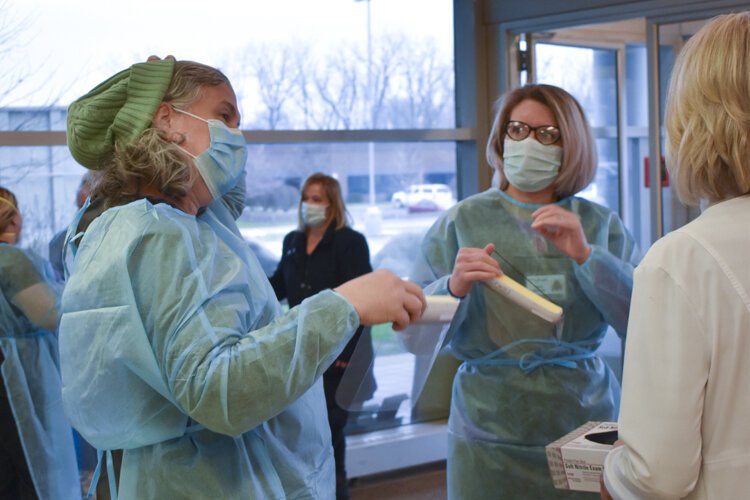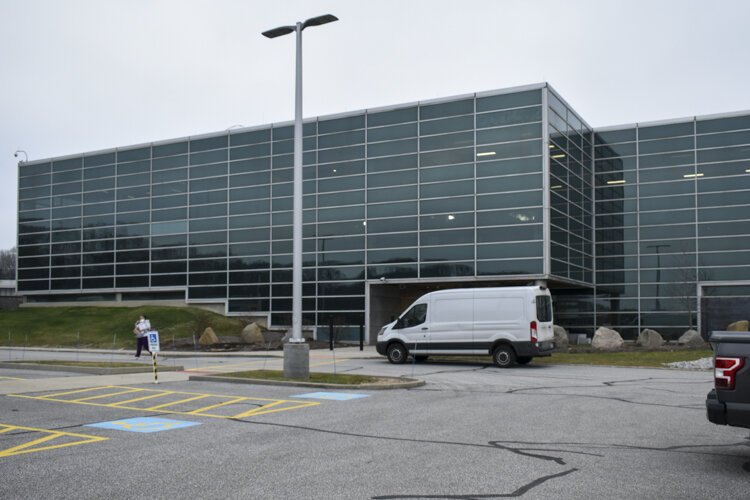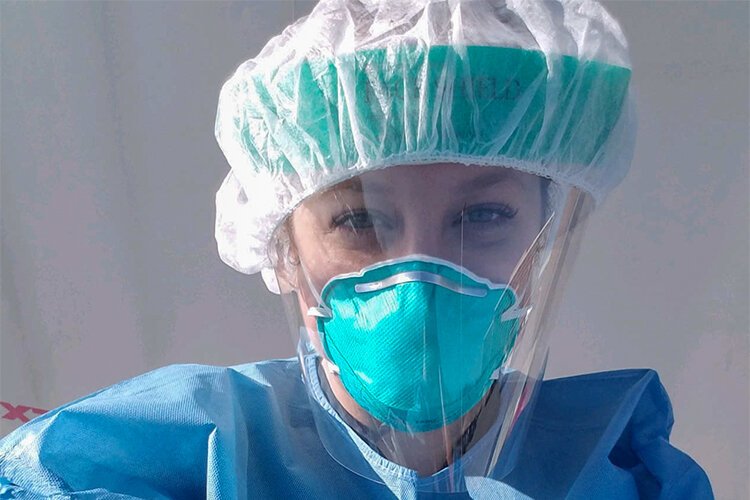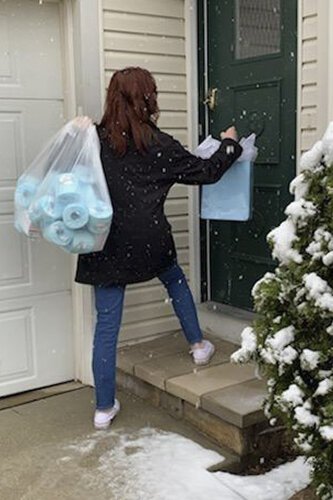In the trenches: Home healthcare providers take extra steps to keep everyone safe during visits
On every visit, Max, the family husky, barks at visiting nurse Tara Brown as she arrives at the home of Ken Wantz and his older brother Gerry in Hiram. Maybe it’s hard for Max to recognize Brown under her Personal Protective Equipment (PPE)—the full gown, mask, goggles, and gloves—as she delivers medication for Gerry, who’s living with mental illness.
Brown reassures Max with a calming voice and asks the brothers how they’re doing. “I’m a second pair of eyes for Gerry’s medical team,” Brown explains. “And I support Ken when he’s feeling overwhelmed by his role as caregiver.”
In 2020, the National Alliance for Caregiving reported that 53 million Americans—caregivers just like Wantz—were providing unpaid care to an adult with a health or functional need. It’s a difficult position for families to be in, balancing their jobs, children, and the care itself. That’s why steady support from visiting home professionals like Brown is so important.
After COVID-19 hit, caregivers had to make some hard choices—halt the home care services their loved ones depend on, or potentially risk health and safety at home with care workers coming in for support.
As Gerry’s guardian, Wantz had to make that decision himself. “Caring for my brother is hard, but I love him and don’t want him to be back in a hospital,” he says. Wantz chose to maintain weekly visits with Brown so that his brother could live at home and get the care he needed.
 Nicole McGivern, a clinical manager puts on her PPE gear.New approaches in caring for the homebound
Nicole McGivern, a clinical manager puts on her PPE gear.New approaches in caring for the homebound
When the pandemic upended the operations of most healthcare providers last March, the entire home health industry had to pivot. Registered nurses, like Brown, are now decked head-to-toe in PPE when visiting their patients, meticulously tracking when they enter and leave homes.
Other agencies are delivering supplies to homes and setting up virtual platforms to reduce personal contact. Cleveland service providers have soldiered forward to provide unique solutions for safe in-home care.
Home care professionals also include personal care aides. These aides are assigned four- to eight-hour shifts to assist their clients with Activities of Daily Living Support (ADLS)—such as meals, light housekeeping, and personal care in their homes. “When the pandemic hit, these aides were already caring for the most vulnerable of our society—seniors,” says Vicki Hoak, executive director of Home Care Association of America. “But home care organizations weren’t used to PPE. Everyone had to get COVID-19 certification training.”
VNA of Ohio’s SWAT Team defends patients against COVID-19
Providing services to 1,000 patients, with 35 to 45 visits a day, the Visiting Nurses Association of Ohio (VNA), Brown’s organization, had to devise new methods fast.
VNA of Ohio president Lisa Zidek says the organization provides nursing care, mental healthcare, rehabilitation therapies, hospice, and private-duty services for patients who are homebound. “With so many patients, PPE and new policy procedure protocols were essential in maintaining safe, efficient home visits,” says Zidek.
Like many other healthcare organizations, VNA’s nursing staff were trained in PPE procedures according to guidelines from Centers for Disease Control and Prevention (CDC). But a unique COVID-19 “SWAT team” of nurses and clinicians was also assembled. This group follows advanced protocols in preparation, home visit procedures, and data management. VNA SWAT teams test and care for COVID-19 positive patients and suspected cases in the home.
Traditionally, VNA nurses travel solo, fulfilling their assignments and traveling distances between homes. With the new SWAT team model, the nurses travel in pairs. “One nurse goes into the home to deliver medical services and the second nurse remains outside with a tablet,” says VNA Ohio executive director of home health Amy Ruffner. The indoor nurse communicates vitals, data, and notes—via cell phone—to the outdoor nurse, who manages all recordkeeping on a tablet.
 Nicole McGivern, left, a clinical manager with VNA Ohio,and Sandy Federico, right, a nurse with VNA Ohio, talk as they put on their PPE gear.The SWAT teams also wear extra PPE, which includes a clear face mask over a N95 respirator, three pairs of gloves, a gown, and shoe coverings. The indoor nurses complete clinical work, and once they’re outside of the home, they roll up their PPE—inside out, into a ball and drop it into the biohazard bag held by outdoor nurses.
Nicole McGivern, left, a clinical manager with VNA Ohio,and Sandy Federico, right, a nurse with VNA Ohio, talk as they put on their PPE gear.The SWAT teams also wear extra PPE, which includes a clear face mask over a N95 respirator, three pairs of gloves, a gown, and shoe coverings. The indoor nurses complete clinical work, and once they’re outside of the home, they roll up their PPE—inside out, into a ball and drop it into the biohazard bag held by outdoor nurses.
“Following this policy procedure protocol, not one single COVID SWAT team clinician between New Jersey and Ohio has contracted COVID,” Zidek says.
Many adults with disabilities live in group homes that the VNA nurses visit. “Residents are especially vulnerable to the coronavirus,” says Ruffner. “But the recovery rates charted for the COVID-positive patients we have treated have been very high.”
Cuyahoga County agency connects with family caregivers
In 2020, Cuyahoga County Board of Developmental Disabilities (now known as Cuyahoga DD), in Cleveland, provided services to 10,000 individuals with developmental disabilities of all ages. About 6,300 of these residents live in the city of Cleveland.
The first COVID-19 surge in 2020 alerted the agency to vulnerabilities of its families in this novel pandemic. The kind of services the board coordinates include in-home early intervention programs for babies and toddlers, specialized therapies, and respite care. It also connects adults with vocational training, community employment and supported living models like group homes.
In April 2020, the agency reached out to 4,200 families who were no longer receiving services—just to check in and see if they now needed any new support. “Many families were doing well, but others had just lost their jobs,” says Janet Keeler, general manager of community and workforce development. “We began to explore ways to help individuals and their caregivers navigate the new normal.”
 The "Cuyahoga DD Cares" initiative has done a recent "Shop & Drop" to stock group homes with PPE and paper products.Agency leverages strengths to support residents at home
The "Cuyahoga DD Cares" initiative has done a recent "Shop & Drop" to stock group homes with PPE and paper products.Agency leverages strengths to support residents at home
Over the years, Cuyahoga DD has developed expertise with adaptive equipment and assistive technology. Adaptive equipment helps increase mobility and independence in the home. Assistive technology includes devices that helps people work around their challenges.
Cuyahoga DD’s Lending Library has 3,000 pieces of equipment, like video doorbells, watch minders, and adaptive switches, that are loaned to families to try out in their homes. “Early on in the pandemic, we tried to improve internet connectivity for families,” says Keeler. “We trained families in how to access virtual programs, through tablets, laptops and smartphones." Staff also researched internet providers and shared information on discounts and open hotspots free for public use, Keeler says.
Cuyahoga DD supports providers of residential services for adults with developmental disabilities, which are staffed mostly by Direct Support Professionals (DSPs). When day programs—like employment and activities centers—closed, residents had to stay home all day. Many DSPs have had to work longer shifts to lead entertaining activities for residents during the day.
To provide more support to the homes, the Cuyahoga DD board launched the “Cuyahoga DD Cares” initiative to encourage volunteers to “adopt” a residential setting. This initiative, which began with employees delivering much needed PPE and cleaning supplies, evolved into employees using their own funds to purchase activity supplies, games—and even pizza—and dropping them off at 155 residential settings in Cuyahoga County.
Cuyahoga DD also partners with the Cuyahoga Board of Health to provide COVID-19 testing for adults in group residential settings.
Bright Beginnings plans a virtual model to help babies and toddlers with delays
In 2020, 2,605 young families in Cuyahoga County relied on home visitation from Early Intervention (EI) specialists. Children, from birth-to-age three, diagnosed with a disability or delay receive in-home intervention by therapists from Cuyahoga DD. Therapy services are coordinated by Bright Beginnings in Independence.
“Cuyahoga DD partners with Bright Beginnings to create an Early Intervention team for each child,” says Karen Mintzer, director of Bright Beginnings. “With the family, the team sets goals for the baby’s development. Before COVID-19, therapists worked directly with the child at home or the daycare.”
 Registered nurses are now decked head-to-toe in PPE when visiting their patients, meticulously tracking when they enter and leave homes.But after COVID-19, requests for home visits with EI therapists dropped off abruptly as families feared for their children’s safety, Mintzer says.
Registered nurses are now decked head-to-toe in PPE when visiting their patients, meticulously tracking when they enter and leave homes.But after COVID-19, requests for home visits with EI therapists dropped off abruptly as families feared for their children’s safety, Mintzer says.
“Across the country, there was general family concern about health care professionals bringing COVID-19 into the home,” Hoak confirms. “But in fact, many personal care aides were also getting exposed by their clients.”
Early Intervention teams adapted their home visiting model for families through a new method called Tele-Intervention. The parents work with the child as the therapist watches remotely, coaching the parents. “Parents are their child’s first, most important teacher,” says Mintzer. “That’s why it’s been exciting to see parents lead these activities, with the virtual assistance of a therapist coach.”
Tele-Intervention is so new there's not much data to show how well the approach is working for families yet. The model also relies on internet connectivity, which many working and poor families don’t have access to in Cleveland.
But Linh, a Cleveland mom of a two-year-old son, says she believes this model of EI is working for her family. “Being first time parents, Bright Beginnings is like having training wheels for the journey of parenthood,” Linh says. “We have a better ability to communicate and understanding our child’s thinking.”
Through trial and error and thoughtful planning, Cleveland providers have fine-tuned new solutions to care for their homebound and stay-at-home clients. Providers have demonstrated that PPE brings new levels of safety to the home. Creative thinking in virtual spaces, like video conferencing software, have made programs and services even more accessible. When vaccines and connectivity are available for all families, there will be no place like home.
This story is sponsored by the Northeast Ohio Solutions Journalism Collaborative, which is composed of 20-plus Northeast Ohio news outlets including FreshWater Cleveland. Report for America Corps Member Conor Morris contributed to this story.






